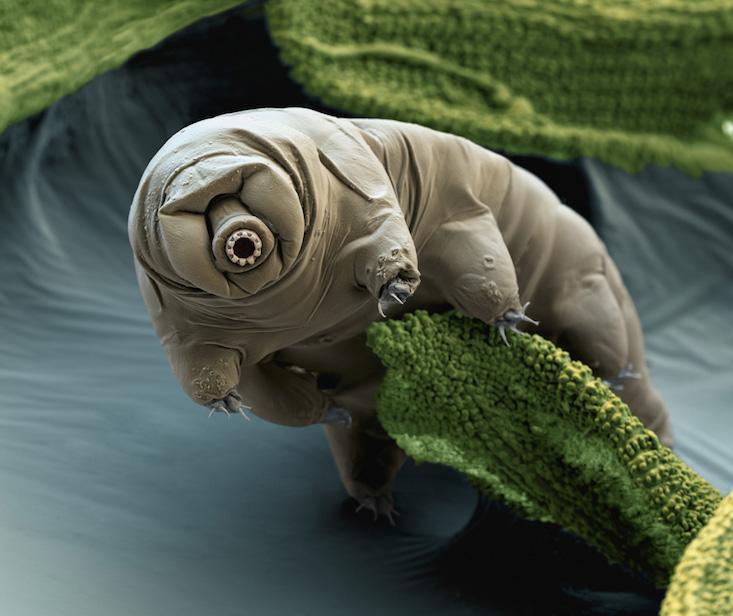
With global climate change, habitat loss, poaching, pollution, and environmental abuse of all kinds, these are tough times for the natural world, which is all the more worrisome given the widespread assumption that life is delicate and fragile, often painfully so.
At the same time, it is becoming increasingly clear that unlike individual lives, and the extinction-prone vulnerability of many species, life itself is paradoxically robust. Enter: extremophiles. This word didn’t exist a few decades ago, and has only entered widespread use in the 21st century. It refers to organisms that survive—even, thrive—in environments that are extremely hot, cold, highly acidic or alkaline, circumstances that would be lethal for most living things. Not surprisingly, their mere existence has excited the admiration and wonder of biologists.
The first asphalt roads in such eastern U.S. cities as New York, Baltimore and Washington, D.C., were paved with natural asphalt taken directly from Pitch Lake, in Trinidad. The first Europeans to discover this natural curiosity, in 1595, were under the command of Sir Walter Raleigh, who used pitch from this lake to caulk his ship, noting in his diary that the material was “most excellent… It melteth not with the sun as the pitch of Norway.” More than four centuries later, scientists discovered abundant microbial life, luxuriating in this same lake of liquid asphalt, an environment that would seem more appropriate to one of Dante’s infernal regions than a life-affirming Petri dish. Nor is this finding unique.
In 2013, bacteria were reported to be thriving in a cold, dark lake (of more traditional water), one-half mile under the Antarctic ice. A month later, microbes were found occupying the deepest place on Earth, the Marianas Trench. There are also “infra-terrestrials” which live, incredibly, inside rocks in the deep ocean, nearly 2,000 feet below the sea floor, which itself is under 8,500 feet of ocean, and not just utterly dark, and devastatingly cold, but subject to immense pressure. Living things—thermophiles—have also been found in super-heated oceanic vents, at temperatures up to 122 degrees Celsius, which is considerably hotter than boiling water.
You can boil them, freeze them, dry them, drown them, float them unprotected in space, and expose them to radiation.
Given that life can succeed in extreme environments, maybe it first evolved in them as well. It was long assumed, for example, that life must have originated in some sort of warm, shallow, benevolent puddle that offered the kind of comfortable incubator that such a delicate flower would require. This may have been the case. However, the existence of thermophiles thriving in super-heated, hydrothermal deep ocean vents, along with the discovery of numerous other extremophiles has raised the prospect that perhaps life first emerged in what we—sunny children of a relatively easy, superficially life-friendly environment—have until recently considered impossible conditions.
It has also evoked considerable interest from astrobiologists. Hence, the special significance of life abounding not only in conditions that are super-heated (thermophiles) as well as super-cooled (cryophiles), but also in anaerobic conditions, in intensely salty environments (halophiles), getting nutrition from methane (methanotrophs), radiation-resistant organisms that can cheerfully gargle with the effluent from nuclear reactors, or capable of not only surviving but even thriving among heavy concentrations of such traditionally toxic heavy metals as arsenic, cadmium, copper, lead and zinc.
Most extremophiles are microbes, but not all. There are, for example, a group of wingless, mostly eyeless insects known as grylloblattids, more commonly ice-bugs or ice-crawlers. They live, as you might expect, in very cold environments, typically under frozen rocks. My personal favorites, however, are tardigrades. These multicellular creatures are rarely more than one millimeter in length and often invisible to the unaided eye. They have three pairs of legs along each side and then another pair at their rear end, each leg outfitted with tiny claws. They have a clearly discernible mouth and are, frankly, adorable. Purists don’t include tardigrades among extremophiles, since they do not appear adapted to extreme environments per se—like us, they do better in comparatively benign conditions, which, in the case of tardigrades, includes the moist, temperate mini-world of forest moss and lichens. Their probability of dying increases in proportion as they are exposed to highly challenging circumstances, so unlike classic extremophiles, they are evidently adapted to what human beings, at least, consider moderate circumstances.
Tardigrades can even be cooled to just a few degrees above absolute zero, at which point atoms virtually stop moving.
However, tardigrades are extraordinary in their ability to survive when their environments become downright extreme. Typical extremophiles specialize in going about their lives in conditions of extremis, normally managing this feat along only one environmental axis. But tardigrades are unique: They can survive when things get dicey along many different and seemingly independent dimensions, come what may. You can boil them, freeze them, dry them, drown them, float them unprotected in space, expose them to radiation, and even deprive them of nourishment—to which they respond by shrinking in size. These creatures, also known as water bears, are featured on appealing T-shirts with the slogan “Live Tiny, Die Never,” and a delightful rap song describing their indifference to extreme situations is titled “Water Bear Don’t Care.” These tiny animals might be the toughest on Earth.
You can put them in a laboratory freezer at minus 80 degrees Celsius, leave them for several years, then thaw them out and they’ll be running around as though nothing had happened just 20 minutes later. They can even be cooled to just a few degrees above absolute zero, at which point atoms virtually stop moving. Once thawed out, however, tardigrades move around just fine. (Admittedly, they aren’t speed demons; the word “tardigrade” means “slow walker.”) Exposed to super-heated steam (140 degrees centigrade), they shrug it off and keep on living. Not only are tardigrades remarkably resistant to a wide range of what ecologists term environmental “insults,” they also have a special trick up their sleeves: when things get really challenging—especially dry or cold—they convert into a spore-like form known as a “tun,” which can live (if you call their unique form of suspended animation “living”) for decades, possibly even centuries, and survive pretty much anything that nature might throw at them. In this state, their metabolism slows to less than 0.01 percent of normal.
In short, they possess the kind of super-powers we otherwise associate with comic book superheroes. But they have two tricks in their playbook: For one, it has recently been discovered that they possess genes that produce a peculiar array of constituent chemicals, known as “intrinsically disordered proteins,” which help induce a solid internal state in these animals when they experience desiccation.
And for another, fully one-sixth of their DNA consists of genetic material from other species. It has long been known that some cross-species—horizontal—transfer of DNA takes place, but not on the scale exhibited by water bears. Most animals sport less than 1 percent foreign DNA. A possible explanation for how tardigrades developed this ability is that when these animals dehydrate in response to environmental exigency, their DNA breaks into fragments, after which it is reconstituted upon rehydration. All species possess some capacity to repair errors in their genome; those individuals incapable of this maneuver will have been selected against, simply given the unavoidable tendency of DNA to mutate, even without the extra challenge of adjusting to extreme conditions. As tardigrade genes reconstitute themselves from the tun state, their cell and nuclear membranes become leaky, whereupon they might have acquired the habit of incorporating various pieces of non-tardigrade DNA which are inevitably floating around.
Although presumably the stitching in of extra-specific DNA is initially random, it is entirely possible that some of these genomic additives were especially likely to contribute to their possessor’s fitness, whereupon they were projected into future generations, a process made all the more likely under conditions of fluctuating environmental harshness. If so, then one consequence of tardigrade adaptation to extreme conditions—for example, the ability to close down their metabolism and suspend normal DNA structure—will itself have contributed to their ability to adapt to those conditions, by facilitating the incorporation of those occasional DNA snippets that enhance survival and reproduction.
However this process began and whatever reason it persists, the high level of cross-species DNA transfer among tardigrades suggests a rethinking of the traditional understanding whereby genes are only transmitted vertically, from parents to offspring. These unusual creatures emphasize how a linear tree of life must make room for a complex, horizontally branching web. J.B.S. Haldane once wrote that “the universe is not only queerer than we imagine but queerer than we can imagine.” Extremophiles such as tardigrades demonstrate that life is not only “queerer” than most of us have imagined, but also more resilient.
In an increasingly bio-unfriendly world, extremophiles in general and tardigrades in particular provide a tiny ray of hope.
David P. Barash is an evolutionary biologist and professor emeritus of psychology at the University of Washington. This article is modified from his book, Paradigms Lost: The Pain And Pleasure Of Seeing Ourselves As We Really Are, to appear next year from Oxford University Press.
WATCH: The scientific illustrator Cornelia Hesse-Honegger on how the ubiquity of images has changed how we see.































